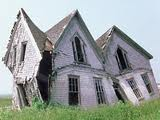If you’re buying a home, before you decide on whether this home is your dream home, use the following checklist to help you look at prospective homes with a critical eye!
- Print the Buying a Home – Essential Considerations checklist and put it on a clipboard.
- Mark the features you see and note their general condition on this list, when you find a home that really interests you.
- Fill out in the space and check the box of the one that best describes each home, where I’ve provided choices.
If you don’t know the answers to any question, then make sure to ask your Real Estate Sales Representative. Some technical issues should be established by a home inspector.

A minor problem now can become a major, and expensive, problem down the road.
Although home sellers may not always disclose the whole truth about the condition of their home, you most likely aren’t interested in paying for a professional inspection at every house you tour. There are several key areas that every buyer should pay close attention to when viewing prospective homes. Taking extra time to investigate these areas before you sign on the dotted line may help to waste time on a home that needs too much work or worse having to spend thousands of unwanted dollars after the purchase of your new home. Here is a list of some things to look out for:
Foundation Cracks. Examine the foundation from the outside and inside, too, if accessible. Look for horizontal cracks or any cracks bigger than one-third of an inch, which could mean serious structural problems. If the yard slopes toward the house, look for signs of water damage in the basement.
Bad or Strange Odors. Pay attention to smells in each room of the house, and even on the outside of the house. Cigarette smoke and pet odors can be difficult to hide. If a home smells heavily of cleaning products (especially bleach) or deodorizers, the seller may be trying to cover up a stinky situation.
Mildew and Mold. Check for signs of mold on basement walls and in laundry rooms. White or green colonies of mold can also indicate excessive water in the crawl space or basement. This can mean that soil needs to be brought in around the foundation to keep the water sloping away from the house.
Roof. Look for defective roofing and/or flashings, missing or falling shingles, curling shingles, flat spots in the roof that trap water, and low slope roofs that have shingles.
Weak Water Pressure / Old Plumbing. Check the water pressure by running the bathroom sink and flushing the toilet at the same time. Low water flow may indicate plumbing problems, such as corroded pipes that need to be replaced. New pipes can run as high as $15,000 in a typical 1,500-square-foot home.
Ceiling and Wall Stains. Water stains in a bathroom may indicate the shower or sink is leaking and needs to be re-caulked. It could also require ripping out tile and replacing the shower pan, which costs around $1,500 or having a plumber come in to repair the sink. Most roof leaks that come from the ceiling could be a result of neglected flashings that seals “valleys” in the roof or around a chimney or vents, which may cost up to $500. But roof leaks may also mean it is time to replace shingles, which could cost in the thousands of dollars. You may also want to take a look in the attic for broken trusses that could be causing leaks.
Doors That Don’t Close. If more than one door won’t close or swings open by itself, it may indicate a structural issue, such as a foundation that has settled or framing that is deteriorating.
Locked Doors. Inquire about any doors that are locked or marked “off limits” during your home tour. The homeowners may be trying to hide something.
Old or Faulty Wiring. Ensure all the switches and outlets in the house function properly. Flickering lights, circuits that don’t work and hot outlets or faceplates are all symptoms of wiring problems. Electrical needs for today’s appliances and electronics may exceed the capacity of homes built as little as 10 years ago. You may end up spending $2,500 or more to have an electrician update the electrical system.
Non-functioning Windows. Open and close all windows. Feel for irregular or large pockets of air drafts. Check for cracks and water in between double-paned windows.
If you enter negotiations to buy a house in Mississauga area, it is wise to always put in a condition on having a professional inspect the home for minor and major problems. Even brand new houses can have problems that the builder has overlooked. A minor problem now can become a major, and expensive, problem down the road. Most of these problems can be repaired, but depending on the specific problem; the cost can be substantial, which makes it the deciding factor in whether you ultimately buy the house.

Waiting for the market to cool off before buying a home could end up costing you more money then it would if you bought a home now and took advantage of the lower mortgage rates mortgage.
With predictions of home prices set to fall many potential home buyers including home upgraders are choosing to sit on the sidelines and take a wait and see approach with their real estate plans. Home buyers refusing to participate in multiple offers are also bowing out until the market cools off a bit. Is this the right approach?
Since March when predictions were released that Mississauga Property values along with most other areas of the GTA would experience a price reduction of 20—25%, the Mississauga real estate market along with most other markets across the GTA have continued to flourish. During the first two weeks of April the average selling price of a home increased by 1% as compared to the average selling price at the end of March 2012. Although this average price does not necessarily mean that all homes have increased 1% in value in two weeks, it provides some guidance that home prices are still on the increase. By the end of the month the year over year increase in average selling price was up by 8%. Total sales figures were up 18% over last April.
The inventory of homes on the market continues to be very tight and there are more buyers out there then there are homes for sale. The hope is that as we move further in to spring the inventory will increase and prices will stabilize. If not then what next?
A continued tight inventory will push prices up even further. At the current level of monthly increases in the average selling price that could amount to an increase of about 12% over the next year. Based on the year over year average increase of 10% published for March 2012, this 12% doesn’t seem totally out of whack.
The Canadian economy seems to be moving along quite well and according to the “Big Bank Chief” if it continues to improve a gradual increase in the central bank rate could lead to an increase in lending rates. Some economists believe the increase will start towards the end of 2012.
Typically the real estate market doesn’t react quickly to moderate economic changes. Historically in an increasing interest market it takes about 6 months before the rate increases have an effect on home prices. Given the record low rates in the market right now it would not be unreasonable to assume that, should the central bank begin to raise rates at the end of the year that actual mortgage rates will be 1% higher by this time next year. Given the current market conditions and the length of time it takes the market to react to changes waiting for the market to cool off before buying a home could end up costing you more money then it would if you bought a home now and took advantage of the lower mortgage rates mortgage.

